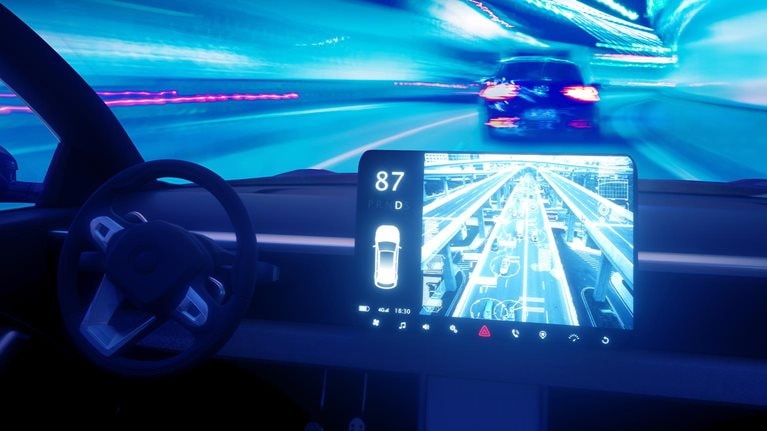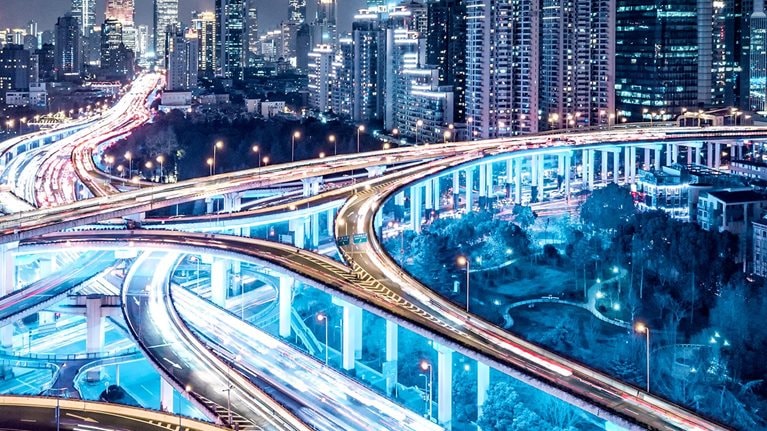Before the end of this decade, autonomous vehicles (AVs), electric vehicles (EVs), and shared forms of mobility are poised to transform the mobility landscape. How will the auto insurance landscape evolve to adapt to this wave of disruption?
This is a large question with many, many answers. At ITC Vegas 2023, McKinsey brought together a group of 20 leaders from auto insurance, automotive, and mobility to discuss the future of the industry (see sidebar, “About the research”). Despite the convergence of expertise, the diverse perspectives highlighted the complexity and dynamic nature of the characteristics expected to separate winners from “also-rans” in the coming years.
Is the emerging mobility paradigm real or a mirage?
Accelerating investment in emerging mobility technologies signals a transformation in the landscape within the next five to ten years. Market participants optimistic about the pace of innovation expect that by 2030, roughly half of new vehicles will be electric, nearly all new vehicles will be connected, and some (maybe one in six) will have Level 3+ autonomous-driving capabilities—such as self-driving without constant human supervision.1 On the same timeline, industry participants expect that approximately one-third of personal miles traveled will likely be attributed to micro- and shared-mobility solutions, such as bikes and ride-hailing services. These are not mere technological shifts in mobility; these are forces that fundamentally alter how we perceive and interact with personal mobility.
While these industry participants express optimism, others are more skeptical about the timeline for mass adoption of emerging technologies—highlighting as barriers regulatory pushback, technical challenges, and reluctance by users to adopt new solutions. Even leading OEMs have found ambitious driverless operations and AV programs too high-risk, citing profitability concerns. According to a 2023 McKinsey Center for Future Mobility survey, the expected timeline for adoption of autonomy across all levels was extended compared with 2021 predictions due to a range of factors, including regulatory challenges, technical obstacles, and the ongoing challenge of securing capital.2 While some pioneers are pushing toward developing full vehicle autonomy, most automakers have decided, instead, to concentrate on more-modest AV tech developed in-house, focusing on partial (Level 2) and conditional (Level 3) driving automation, where drivers must always be available to take the wheel.
What’s happening in insurance?
The auto insurance market is also experiencing significant change. According to McKinsey analysis, before the end of the current decade, the industry is likely to see a peak—and subsequent decline—in premiums for conventional auto personal lines coverage, currently estimated at approximately $260 billion (Exhibit 1). This scenario would see widespread, baseline adoption of advanced driver assistance systems (ADAS) features and expected consumer shifts toward greater acceptance of (and reliance on) semi-autonomous driving capabilities. Many factors, such as faster than anticipated adoption of leasing or subscription models for commercial AVs, could make way for even more disruption of the current industry status quo.

While traditional insurance stagnates, a new auto insurance model is emerging, ripe for carriers (and, potentially, new market entrants) to capture. This $100 billion market is characterized by distinct distribution, product, pricing, and claims handling—systematically using, for example, sophisticated telematics for pricing, distribution embedded at the point of vehicle sales, and coverages for as-yet-unseen generations of AVs and EVs.
Targeting this new “disrupted” auto insurance space likely requires investments in capabilities, partnerships, and know-how for market leaders. The rapid rise of EVs, for example, introduces new dynamics in risk assessment and premium calculation. The unique maintenance needs, repair costs, and battery life of EVs necessitate a recalibration of traditional insurance models. Insurers are expected to grapple with the nuances of insuring vehicles that are increasingly software-driven and connected, posing distinct challenges in terms of cyber security and liability.
The introduction of Level 3+ AVs will further complicate the insurance landscape. As driving responsibilities shift from human to machine, questions about liability and risk assessment become increasingly complex. Insurers will need to consider the implications of software reliability, the potential for system failures, and the changing nature of driver behavior in response to autonomous technologies. Before long, we will see distinct coverages related to the risk of drivers, AV software developers, and hardware builders. As technology matures and depending on local regulations, liability is likely to shift more and more toward OEMs or system providers, boosting commercial auto premiums and elevating the role of reinsurers providing capacity to this new market.
How true is the promise of driver and vehicle safety technology?
Distracted driving, largely due to smartphone use, remains the leading cause of accidents today, typically combined with pedestrian crossings or vehicles ahead braking. Data from Nauto suggests drivers face an average of six to seven distractions per hour.3
Technological safety solutions hold promise in altering driver behavior and automating driving activities, potentially reducing accidents that currently result in 25,000 road deaths annually in the United States. Yet ADAS face limitations. Lane departure warnings, for example, suffer from high error rates and user pushback, with drivers who find them nonintuitive or intrusive often deactivating them. Compounding this issue, ADAS technology embedded in vehicles is typically running a few years behind the latest advancements in driver safety technology, a consequence of a typical auto development cycle of five to seven years in the United States (compared with two to three years among Chinese OEM new entrants).
The future of vehicle safety technology likely lies in more sophisticated systems that can more effectively mitigate driver inattention and distraction. While we expect emerging technologies to eventually reduce the incidence of distracted driving materially, OEMs face potential regulatory and consumer pushback. The challenge for automakers and technology providers is to create safety features that enhance, rather than detract from, the driving experience.
The integration of AI and machine learning into vehicle systems offers a promising avenue, potentially transforming road safety. However, the road map to capture such benefits through automation, as of now, remains unclear for most industry players.
Regardless of the specifics facing individual companies, these technological advancements dictate an industry-wide shift in risk assessment and policy design. Insurers might need to adapt to a landscape where vehicle safety technology plays a more prominent (if not central) role in mitigating accidents. Carriers that build a deeper understanding of the effectiveness of different safety features and their impact on driver behavior are, inevitably, the ones that are able to price and select the right risks. At the same time, the industry is called to navigate the complexities of insuring vehicles that are increasingly reliant on sophisticated software as they share roads with vehicles built before 2020 that have more-limited tech capabilities.
Will carriers insure cars or software?
Software is expected to be a major driver of vehicle investment, profit, and distinctiveness in the coming years.4 Software-defined vehicles (SDVs) represent a paradigm shift in the automotive world, where the decoupling of hardware and software components is central. This decoupling—alongside a centralized software architecture, enhanced connectivity, and cloud management—is redefining the traditional vehicle value chain. SDVs usher in a model of more dynamic interaction between OEMs, cloud platforms, third-party consumer experience providers, and a range of suppliers and service providers.
This is not only a shift in vehicle functionality but also in the economic and experiential aspects of vehicle ownership and use. SDVs open avenues for new business models for OEMs, such as software-as-a-service (SaaS) and subscription-based models, enabling automakers to generate recurring revenue. New entrants, meanwhile, are presented with opportunities to develop software for ADAS, autonomous vehicles, and connected services, injecting fresh innovations into the industry. SDVs can potentially reduce development costs, allowing OEMs to reuse software components across multiple vehicle platforms and foster the building of increasingly complex and sophisticated features. This is particularly crucial in the EV market, where differentiation increasingly relies on software rather than hardware features.
However, the transition to technology-heavy EVs and SDVs is not without challenges, as seen in recent incidents involving both new disruptor OEMs and incumbents in which software failure led to recalls. While most of these incidents were resolved simply with over-the-air (OTA) updates, they still drew the attention of authorities, including the National Highway Traffic Safety Administration (NHTSA).
For insurers, advanced EVs and SDVs present a mix of challenges and opportunities. The increasingly software-centric nature of vehicles necessitates a deep understanding of software reliability and cybersecurity implications.
Insurers must adapt to a landscape where vehicle software plays a critical role in safety and functionality. This necessitates innovative insurance products that cater to the unique risks and liability models associated with SDVs. For example, insurers are now called to make dynamic risk assessments that consider emerging mobility contexts (such as automated driving features and OTA updates that fundamentally alter the risk profile of the vehicle) in addition to individual driver attributes (for example, age or driving record).
Furthermore, SDVs’ sophisticated software and electronic components, including sensors essential for functionalities such as autonomous driving and ADAS, in turn escalate the costs associated with physical-damage claims. For instance, a simple windshield replacement that might have previously cost about $300 can now reach $1,000 or more due to the integration of sensors and the requirement to recalibrate this equipment during replacement. Insurers face not only increased part repair costs but also around 25 to 35 percent longer repair time, according to analysis by the McKinsey Center for Future Mobility. Moreover, OEMs are likely to require that critical repairs and maintenance be performed exclusively by certified mechanics for vehicles to maintain warranty coverage, restricting consumers’ freedom to choose their service providers and further escalating repair costs.
What role do regulators play in the auto insurance innovation race?
Regulators aspire to be friends, not foes, of innovation. As the auto insurance industry is navigating a complex and evolving technological terrain, regulators will continue to play a central role in shaping the deployment of these technologies, safeguarding the financial stability of the market, and protecting insureds, drivers, and the general public. Safety is a top priority, and at times, regulators have paused or terminated experiments that they deem put the general public at risk.
Rather than being seen as obstacles to technological advancement, however, regulators are committed to becoming partners to innovators today: for example, several regulator-approved driverless car pilots are operating across the United States, together with robotaxi pilots in key urban areas. Still, safety concerns take precedence—as evidenced by authorities’ swift response to safety incidents in cities such as San Francisco. Notably, that city’s agency has taken action on a case-by-case basis with operators in question rather than a blanket approach applied to the entire industry. Indeed, Waymo continues to operate its fleet of self-driving vehicles in San Francisco.
An additional—and pivotal—concern for regulators is the impact of these changes on the solvency of insurance carriers. As the growth rate in the traditional auto insurance premium pool slows or potentially shrinks because of shifts in the use of different mobility platforms and advancements in vehicle technology and safety, there is a risk that some carriers may not be able to adapt—especially if this premium pool shrinks rapidly. At the same time, regulators are considering that, by 2030, emerging technologies will likely have a radical impact on claims frequency and severity. Advanced technologies, while enhancing safety, are leading to increased claims severity as a result of high costs associated with complex sensors incorporated into vehicles. This increase in severity, however, is not coupled with a drastic reduction in claims frequency. Insurance carriers unprepared for the paradigm shift in the market are under regulators’ microscope today.
Concurrently, technological change creates a need for new and updated insurance products tailored to the specifics of autonomous and connected vehicles. As vehicles incorporate more-sophisticated driver assistance and automation technologies, there’s an ongoing debate about how liability will shift, potentially moving from drivers to automakers and technology providers.
Carriers face a diverse range of regulators and organizations influencing insurance regulation, including the National Association of Insurance Commissioners (NAIC), state and city governments, NHTSA, and various state-level Departments of Motor Vehicles (DMVs). Entities such as the California Public Utilities Commission (CPUC) further broaden the regulatory spectrum. Most recently, the Federal Trade Commission (FTC) became involved as a regulator in the space, focusing on data privacy for vehicle-generated data. In this complex environment, carrier liabilities might shift rapidly based on changes in requirements by any one of those agencies. Proactive engagement with regulators is essential for insurers to develop insurance products and adopt operational practices in line with technological advancements.
This diversity in the group of regulators dictates that their regulatory approach to emerging mobility technology and insurance can vary significantly, often influenced by local political context. Some jurisdictions are eager to get tests on the road; others are more hesitant to reduce regulatory barriers too quickly. This range of regulatory attitudes introduces additional layers of complexity for insurers in tailoring insurance products to align with the evolving technological landscape.
Are OEMs set to disrupt insurer incumbents in the insurance landscape?
The landscape of insurance distribution is poised for fundamental changes. Traditional strengths of carrier leaders—such as brand awareness and strong acquisition relationships—may prove to be insufficient in this new environment. As data plays an increasingly central role in risk selection, claims management, and distribution, OEMs might emerge as formidable competitors for insurers. To start, insurers may need to consider the implications of OEMs potentially treating vehicle data as a competitive asset, affecting data sharing and utilization—and opening up new opportunities for collaboration with traditional insurers.
Indeed, some OEMs are exploring direct insurance sales as well as partnerships and other models focused on monetizing data (Exhibit 2). The most vertically integrated model is to create full-stack insurance carriers, embedding insurance at the point of sale and providing a one-stop shop while also taking on ownership of risk, revenue, and the end-to-end insurance journey; two leading US-based auto OEMs leverage this model today. But in the short term, most OEMs are expected to focus on a partnership model, forming alliances with existing carriers or developing platforms to monetize insurance leads and share vehicle data.

This evolving distribution landscape, beyond challenges, presents opportunities for insurance carriers to improve margins and boost growth. At a time when high marketing and commission costs prevent many carriers from maintaining a combined ratio of less than 100 percent and when premiums for conventional auto covers are declining, OEM platforms could provide a lifeline for profitability. These platforms offer a way to integrate vehicle data into policy design and underwriting, improving margins, and to access clients “at the source,” boosting growth rates.
What does the future hold for auto insurers, OEMs, and mobility players?
The auto insurance industry stands at a crossroads of technological innovation and regulatory evolution. For auto insurers, OEMs, and mobility players, these priorities are not just strategies for adaptation but are imperative for thriving in a rapidly changing landscape.
Auto insurers can consider the following:
- Innovate amid change. Prioritize investments in data and technology to improve risk assessment in the era of EVs and AVs.
- Forge partnerships to redefine insurance solutions. Proactively develop insurance products specifically designed for EVs, AVs, and connected vehicles in collaboration with OEMs to access critical vehicle data and expertise.
- Engage with regulators. Actively participate in regulatory discussions to shape and adapt to the changing insurance landscape.
OEMs and mobility players can employ the following:
- Collaborate for integrated insurance. Build a unique value proposition in the insurance ecosystem—especially in distribution—and enhance value for your customers.
- Maximize data value and build partnerships. Utilize vehicle data for unique services, consider beneficial data-sharing arrangements, and build partnerships across the emerging mobility landscape.
- Partner on safety initiatives. Build partnerships with auto insurers to cocreate insurance solutions with a strong emphasis on enhancing driver safety and accident prevention, integrating utilization of ADAS and other safety technologies.
McKinsey’s analysis underscores the potential for substantial disruptions, with more than a quarter of the personal auto insurance premium pool facing shifts in distribution, products, pricing, and claims handling. Amid optimistic projections of an electric, connected, and autonomous vehicle future by 2030, skeptics cite regulatory pushback, technical challenges, and user behavioral aspects as barriers to mass adoption. Recent decisions by major automakers to reevaluate their AV programs underscore the uncertainties ahead. In this dynamic landscape, the imperative for auto insurers, OEMs, and mobility players is not merely adaptation but strategic agility, collaborative innovation, and a proactive engagement with regulators to navigate the complex currents of change and secure a thriving future.


